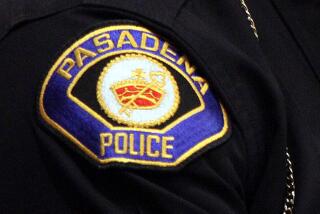Pasadena police chief faces public over fatal shooting
- Share via
How many police bullets actually hit Kendrec McDade, 19 years old and unarmed, on that dark Pasadena street? Do police have to yell “halt” or “stop” before pulling the trigger? Is it standard procedure to shoot from a patrol car? Must they shoot to kill? Why not use beanbags or rubber bullets? Where was the police camera?
Though the crowd’s manner was muted, the questions, passed forward on index cards, came unrelentingly to Pasadena Police Chief Phillip Sanchez as he stood in the sanctuary at New Revelation Missionary Baptist Church on Saturday morning.
The gathering was supposed to address mounting community anxiety about the late-night March 24 incident in which two white Pasadena policemen, responding to a robbery call, fatally shot McDade, a black Citrus College student.
Sanchez said he wanted to “start the healing process” and affirmed his “firm desire to get at the facts,” and said that he had asked the Los Angeles County Sheriff’s Department’s Office of Independent Review to investigate the case. He asked for prayers both for the McDade family and for the officers who shot him.
The incident began when a 911 caller said two men had stolen his backpack and that both had guns. Because of that, Sanchez said, “there is a sense of increased hyper-vigilance for the officers” who went looking for the suspects.
Police said officers were in pursuit of McDade, on foot and in a squad car, when McDade quickly approached the squad car and reached for his waistband. Police said that the officer in the car, in fear for his life, unleashed a volley of shots and that the officer on foot opened fire in fear for his colleague.
Police said the caller, Oscar Carrillo, admitted to fabricating the detail about the guns and has been charged with involuntary manslaughter. Police said McDade had been a lookout as Carrillo’s backpack was stolen from his car.
Responding to the audience’s questions Saturday, Sanchez said firing from a car was “a tactic” available to police, though an unusual one. He said there was not always time to yell “freeze,” and that non-lethal weapons like beanbags were typically employed for planned events, not by police who must make instant decisions.
With the investigation still underway, he said, he could not answer how many times McDade had been shot. Asked whether his officers had to shoot to kill McDade, he replied: “I can’t say. I can’t say because I wasn’t there.”
He said the police car’s camera did not record the event because the officers did not activate the vehicle’s lights and sirens, which would have turned on the camera. “They were not in emergency-response mode,” Sanchez said. “It was not shared with the officers that there was imminent danger.”
To some in the crowd, that explanation made little sense. If police were “hyper-vigilant” amid a report of two armed robbers, why weren’t the lights, sirens and camera activated?
“That one was not answered very well at all. A lot of us, I could tell from the body language, weren’t satisfied,” one of the attendees, Allen Clark, 63, said after the gathering.
A Pasadena resident and retired newspaper pressman, Clark hoped to hear more than he was learning from the media. He said he admired Sanchez’s willingness to face the community and was satisfied with most of his answers, but the explanation for the failure to activate the camera left him uneasy. “There’s something else going on there,” he said.
Kevin McDade, 38, the shooting victim’s uncle, attended the meeting and wore a look of frustration afterward. “None of it makes sense,” he said. “You should know to turn your lights on so it can be videotaped on your car.”
Martin A. Gordon, a leader of the Pasadena Community Coalition, a community group, said the meeting was necessary but that the facts of the shooting remained murky.
“What makes it hard to swallow is this meeting brought up more questions than answers,” Gordon said. “There’s just no way I can fathom the police not telling him ‘Stop, halt, you’re under arrest’” before shooting.
christopher.goffard@latimes.com
More to Read
Sign up for Essential California
The most important California stories and recommendations in your inbox every morning.
You may occasionally receive promotional content from the Los Angeles Times.














